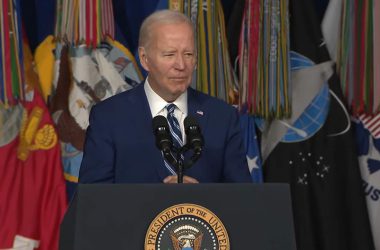Washington, DC—(ENEWSPF)—March 13, 2014.
Mr. Chairman, thank you. Ranking Member Visclosky, thank you, and to the members of this committee, we very much appreciate the opportunity to be here this morning, and I want to particularly note General Dempsey’s presence, who I have come to have the highest regard for and rely on his partnership and wise counsel during the time that I have had the privilege to serve as Secretary of Defense, and I always appreciate him for what he is and what he does and what he represents to this country.
Mr. Hale has been appropriately noted, beatified, sainted, glorified, and I don’t think it is an overstatement at all to note what you have each said about his service, and the sacrifice he’s made to this country, and as Congressman Visclosky noted, it’s probably been as difficult a five year run as comptroller as maybe any comptroller at the Pentagon has ever had. He’s Navy veteran, too, so we didn’t mention that. Well, let the record show, of course, that he’s a Navy veteran. But thank you, Bob, and I will miss you. We will all miss you.
Well, our focus, Mr. Chairman, I know today is, as you have noted, is on the Defense Department’s Fiscal Year 2015 budget. Let me first address, if I might, briefly, the situation in Ukraine.
As you know, the administration’s efforts have been focused on deescalating the crisis, supporting the new Ukrainian government with economic assistance and reaffirming our commitments to our allies, NATO partners, in Europe.
Yesterday, as you all know, the President met with Ukraine’s interim Prime Minister here in Washington, and reconfirmed America’s strong commitment to the people of Ukraine. Secretary Kerry will meet again tomorrow in London, with his counterpart, Russian Foreign Minister Lavrov. And I know Secretary Kerry is here on the Hill today, to address some of the more specific issues on this issue.
Chairman Dempsey and I have spoken with our Ukrainian counterparts, our NATO counterparts, as well as our Russian counterparts, and Chairman Dempsey and I will meet with NATO Secretary General Rasmussen here in Washington next week.
Last week, we put a hold on all military-to-military engagements and exercises with Russia, and directed actions to reinforce NATO allies during this crisis. These include augmenting joint training efforts at our aviation detachment in Poland with 12 F-16s and 300 additional personnel, and increasing our participation in NATO’s Baltic air policing mission by deploying six F-15s and one refueling tanker to Lithuania.
I know that many members of this committee, particularly Congresswoman Kaptur, have been instrumental in helping the United States stand with the Ukrainian people, and I also know that you all in the House, last week, took important action by passing a $1 billion package of loan guarantees for Ukraine. In addition, the President has called on Congress to increase the International Monetary Fund’s capacity to lend resources to Ukraine. I strongly support this effort because the IMF is best positioned to provide Ukrainian government and people with the technical expertise and the financial resources it needs.
Mr. Chairman, the events of the past week, once again, underscore the need for America’s continued global engagement in leadership. The President’s defense budget reflects that reality, and it helps sustain our commitments and our leadership at a very defining time.
I believe this budget, as you have noted in your opening comments, is far more – has to be far more – than a set of numbers or just a list of decisions. It is a statement of values, it’s a statement of priorities, it’s a statement of our needs, it’s a statement of our responsibilities.
It is a realistic budget. It prepares the United States military to defend our national security in a world that is becoming less predictable, more volatile, and in some ways more threatening to our country and our interests.
It’s a plan that allows our military to meet America’s future challenges and threats. It matches our resources to our strategy. And it is a product of collaboration. All of DOD’s military and civilian leaders were included in this effort: the Chairman, the Vice Chairman of the Joint Chiefs, the Service Secretaries, the Service Chiefs, the senior enlisted, and others.
As we all know, America has been at war for the last 13 years. As we end our second war of the last decade – our longest war ever – this budget adapts and adjusts to new strategic realities and fiscal restraints while also, something you noted in your opening comments, is focused on preparing for the future. As we all recognize, this is an extraordinary time. I don’t believe any of us have ever quite lived through this kind of time.
You opened your remarks this morning, Mr. Chairman, saying this is the first time regular order has been dealt with for some time in dealing with budgets. Rarely have we had so much budget uncertainty, living with continuing resolutions as we adjust to a very large and abrupt set of budget cuts.
As a result, this budget is not business as usual. It begins to make the hard choices that we’re all gonna have to make. All of us are gonna have to make some hard choices. The longer we defer these difficult decisions, the more risk we will have down the road, forcing our successors to face far more complicated and difficult choices into the future.
Last year, DoD’s budget cut was $37 billion, because of sequestration. Now, that’s on top of the $487 billion ten-year reductions under the Budget Control Act that DoD was already implementing. December’s bipartisan budget act gave DoD some temporary relief from sequestration, but it still imposes more than $75 billion in cuts over the next two years. And, unless Congress changes the law, sequestration will cut another $50 billion each year starting in Fiscal Year 2016.
The President’s five-year plan provides a realistic alternative to sequestration-level cuts, projecting $115 billion more than current law allows from 2016 to 2019. DoD requires that additional funding to implement our updated defense strategy as outlined in the Quadrennial Defense Review, and to responsibly meet the national security missions of the Department of Defense.
The strategic priorities articulated in the QDR represent America’s highest security interests: Defending the homeland, building security globally, deterring aggression and being ready and capable to win decisively against any adversary. The funding levels in the President’s budget let us execute this strategy with some increased risks in certain areas. And we point those risks out.
These risks would be reduced if Congress approves the President’s Opportunity, Growth, and Security [Initiative], a proposal that would provide DoD with an additional $26 billion in Fiscal Year 2015 to improve readiness and modernization. We have been in a deep hole in readiness the last two years. We’ve deferred many of our most important future programs to keep this country technologically superior and our forces modern. My submitted statement contains details of this initiative, Mr. Chairman, which I strongly support.
Since my submitted statement provides a detailed explanation of our budget request and the rationale behind all of our key decisions, I would like to briefly focus on just a couple of critical issues.
First, the relationship between our Fiscal Year 2015 budget request and our Future Years Defense Program, which was shared with Congress last week. As we all know, Congress appropriates one year at a time. And this committee is focused on drafting and passing a defense appropriations bill for Fiscal Year 2015. The President’s FY 2015 budget request fully funds our preferred long term force levels: 440,000 to 450,000 active Army, 182,000 Marines, and 11 aircraft carriers. We can do this because the Bipartisan Budget Act gave us some certainty in Fiscal Year 2015.
In Fiscal Year 2016 and beyond, sequestration returns and remains the law of the land. In developing our Future Years Defense Program, we chose to plan for two scenarios for FY 2016 through 2019: one where Congress provides DOD the resources needed to support our defense strategy, and one where sequestration level cuts are re-imposed.
We had to do this because future funding levels are uncertain. We just don’t know how much funding Congress will provide for decades or for defense in our FY 2016 budget and beyond. And it would have been irresponsible for our planning to completely ignore the law of the land.
Our detailed planning for sequestration-level cuts showed that sequestration would impose some force structure reductions that simply can’t be implemented with the push of a button. They require precise plans, longer time horizons in planning.
Therefore, our Future Years Defense Program hedges. It projects $115 billion above sequestration level spending on FY 2016 in FY 2016 through 2019, because those are the resources that will be required to execute the President’s defense strategy, although at higher risk for certain missions. But, even though the Future Years Defense Program projects this additional spending, in its later years the plan includes the sequestration-level force structure reductions that take the longest to plan and implement. By the end of 2019, it shows the active Army being reduced to 420,000 soldiers and Marine Corps reductions to 175,000. It also reflects the decommissioning of the aircraft carrier U.S.S. George Washington, even though we are committed to paying for its overhaul, and if we receive funding at the levels requested by the President’s budget we can accomplish that.
But we had to plan for sequestration-level budgets. We are not recommending the sequestration-level reductions, just the opposite. In fact, we’re urging Congress to provide the additional resources requested by the President, but we cannot ignore the reality that sequestration remains the law for Fiscal 2016 and beyond. So we start planning for some of the most challenging decisions required under sequestration. It would be irresponsible not to do so.
DoD leaders all agree that our preferred force structure levels can be sustained if DoD receives appropriations at the President’s budget level over the next five years. And, I’ve codified this in written guidance to the Service Secretaries and the Service Chiefs. But Congress, Mr. Chairman, must reverse sequestration in order for DoD not to plan for these large force structure reductions.
Next, let me address the balance between readiness, capability and capacity in this budget request.
After more than a decade of long, large stability operations, we traded some capacity to protect readiness and modernized capabilities as we shift to focus on future requirements shaped by enduring and emerging threats.
We have to be able to defeat terrorist threats and deter adversaries with increasingly modern weapons and technological capabilities. We must also assure that America’s economic interests are protected, protected through open sea lanes, freedom of the skies and space and deal with one of the most urgent and real threats facing our nation today and will well into the future, cyber attacks. That’s why we protected funding for cyber and special operations forces.
For the active-duty Army, we propose over the next five years, drawing down as I have noted to about 440,000 to 450,000 soldiers. Mr. Chairman, that’s less than 10 percent below its size pre-9/11. We believe this is adequate for future demand, and future threats. We will continue investing in high end ground capabilities to keep our soldiers the most advanced, ready and capable in the world.
Army National Guard and Reserve units will remain a vibrant part of our national defense and will draw down by about 5 percent. We will also streamline Army helicopter force structures by reducing the Guard’s fleet by 8 percent. The active duty’s fleet will be cut by around 25 percent. But, we will still be able to maintain and keep these helicopters modernized as we move from a fleet of seven models to four.
The Navy, for its part, will take 11 ships out of its operational inventory, but they will be modernized and returned to service with greater capability and longer life spans. This will also support a strong defense industrial base. That industrial base, as this committee knows, itself is a national strategic asset that we must not allow to let down.
The Marine Corps will continue its planned draw down to 182,000, but will devote 900 more Marines to increased embassy security.
And the Air Force will retire the aging A-10, replacing it with more advanced multi-mission aircraft like the Joint Strike Fighter.
Now, Mr. Chairman, regarding compensation reform, taking care of our people – as we all know, you are committed to; we are committed to – means providing them with both fair compensation, as well as the training and the tools and the edge they will always need to succeed in battle and return home safely.
To meet those obligations under constrained budgets, we need some modest adjustments to the growth in pay and benefits. All these savings will be reinvested in training and equipping our troops. And there are no proposals to change retirement in this budget.
Let me clarify what these compensation adjustments are and what they are not.
First, we will continue to recommend pay increases. They won’t be as substantial as in past years, but they will continue.
Second, we will continue subsidizing off-base housing costs. The 100 percent benefit of today will be reduced, but only to about 95 percent, and it will be phased in over the next several years.
Third, we are not shutting down commissaries. We recommend gradually phasing out some subsidiaries – or subsidies, but only for domestic commissaries that are not in remote areas.
Fourth, we recommend simplifying and modernizing our three TRICARE systems by merging them into one TRICARE system with modest increases in copays and deductibles for retirees and family members that encourage them more fully to use the most affordable means of care. Active duty personnel will still receive care that is entirely free.
The President’s defense budget supports our defense strategy. It defends this country and it keeps our commitments to our people. However, these commitments would be seriously jeopardized if we don’t have the funds and the resources to be able to implement them.
My submitted testimony details how sequestration would compromise that security. And the result would be a military that could not fulfill its defense strategy, putting at further risk America’s traditional role as a guarantor of global security, and ultimately our own security.
That is not the military the President, General Dempsey, our leaders and I want. It’s not the military you want. It’s certainly not what we want for our future. But it is the path we are on unless Congress does change the law.
Mr. Chairman, members of the committee, DoD leaders and I look forward to working with you, all of you, as we make the difficult choices that are going to be required – difficult choices to continue to assure America’s security and protect our national interests.
Thank you.
Source: defense.gov








